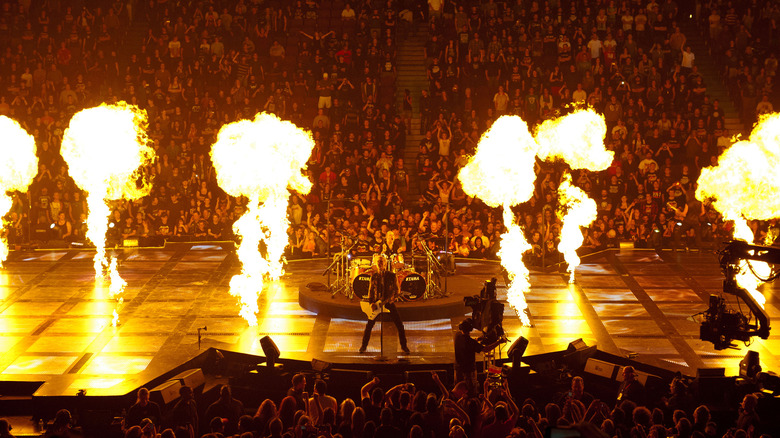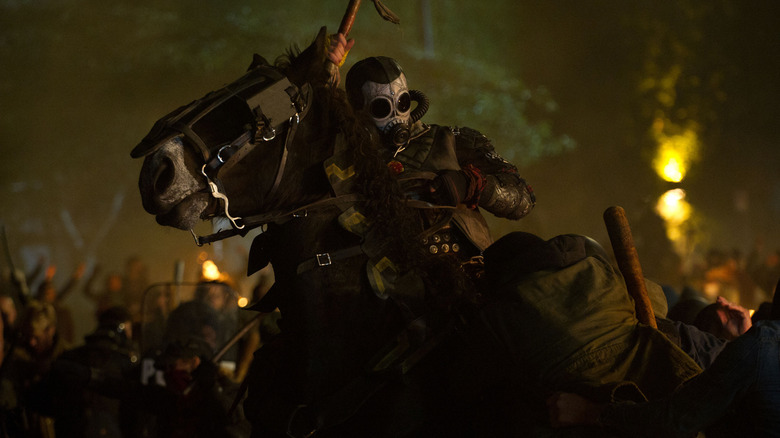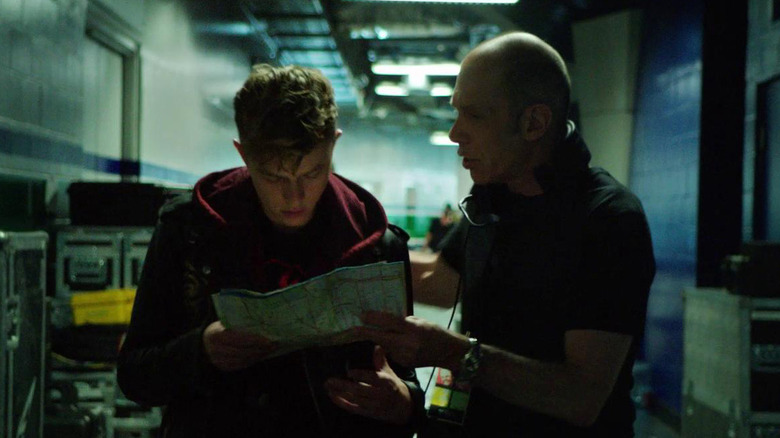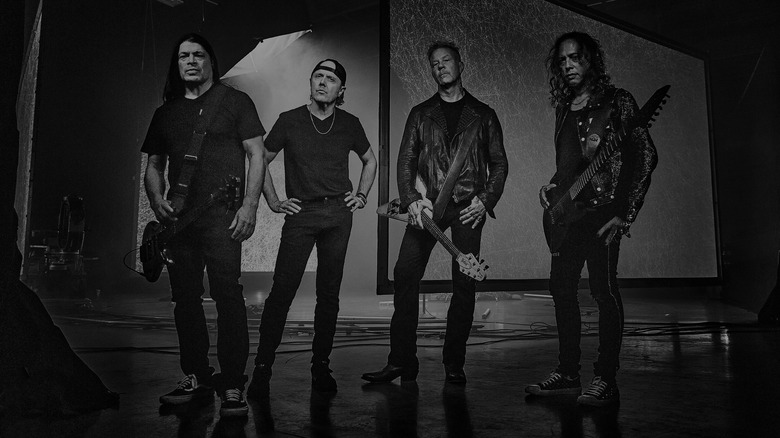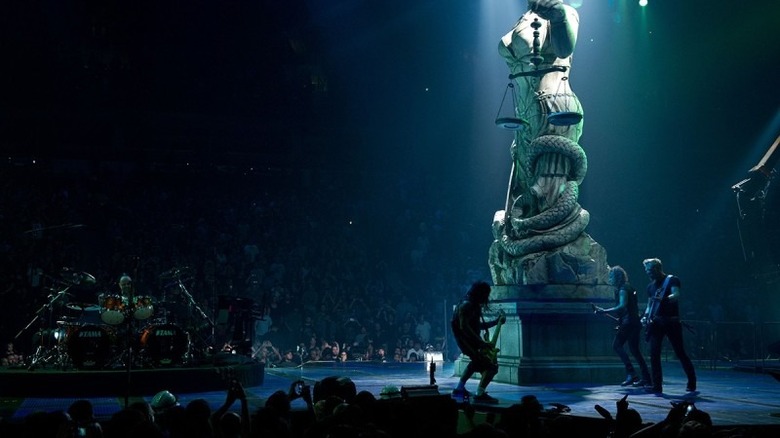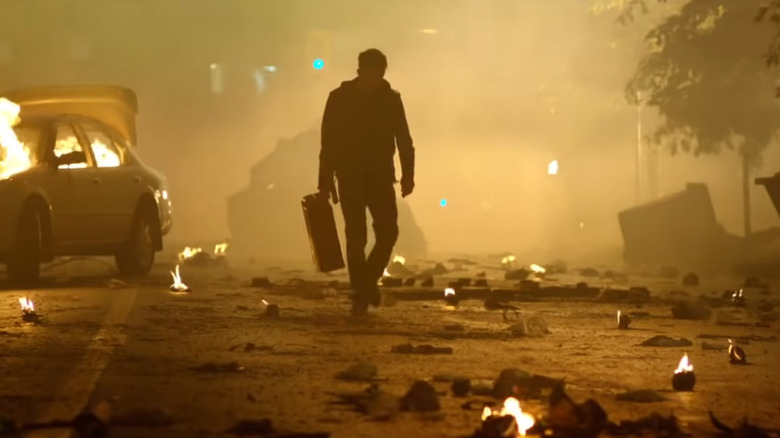10 Years Before Taylor Swift's Eras Tour, Metallica's Concert Film Was A Box Office Disaster
(Welcome to Tales from the Box Office, our column that examines box office miracles, disasters, and everything in between, as well as what we can learn from them.)
Metallica is, without question, one of the biggest music acts in history. They've sold more than 120 million albums worldwide and have played on every single continent — yes, even Antarctica. Not bad for a thrash metal band that seemingly had very little commercial upside and originally tried to call their first album "Metal Up Your Ass." In 2013, after more than 30 years of conquering the music industry, Metallica set its sights on conquering the big screen with a wildly ambitious concert film. Unfortunately for James Hetfield, Lars Ulrich, Kirk Hammett, and Robert Trujillo, the venture proved to be arguably the biggest financial misfire of their storied career.
Released in the fall of 2013, "Metallica: Through the Never" was not only an immaculately filmed 3D concert but an artistic, cinematic narrative tale as well. It was unique, extravagant, and met with much acclaim. It was also wildly expensive and cost the band millions, as they wanted to be in control of the whole thing, which meant they had to put up the money. In truly Hollywood fashion, it just got away from them and turned into a financial catastrophe.
Ten years later, buzzy concert films are back in a big way, as "Taylor Swift: The Eras Tour" promises to be one of the biggest earners of the fall season, with Beyoncé also releasing a film based on her blockbuster "Renaissance" tour. In both cases, things figure to pan out far better than they did for Metallica.
In this week's Tales from the Box Office, in honor of the tenth anniversary of "Through the Never," we're looking back on the film, how it came to be, how it turned into an overly expensive mess, what happened when it hit theaters, and what lessons we can learn from it a decade removed. Let's dig in, shall we?
The movie: Metallica: Through the Never
The notion of a major recording artist making the jump to movies is nothing new. There's the successful "musician turned actor" story, like Eminem and the Oscar-winning "8 Mile." Then there's a mix of music with narrative dating back to The Beatles with "A Hard Day's Night." We can also look at the smash hit Prince was able to generate with "Purple Rain." And yes, we've had plenty of theatrically-released, performance-focused films, such as U2's "Rattle and Hum." The list goes on.
This to say, it made a lot of sense for Metallica to do a concert film. They had just released one of their most acclaimed albums in years four years earlier with 2009's "Death Magnetic" and were regularly able to fill stadiums around the world. Why not movie theaters as well? And so, the band hatched plans to make a big-ass movie rather than do the safer thing and make a follow-up album. Metallica has never played it safe.
"Metallica: Through the Never" was billed by the band as a "groundbreaking music-driven 3D motion picture event." The film is part live performance and part narrative, with the two disparate pieces woven together to make a pretty unique final product. The concert portion features elaborate (and expensive), real live performances that took place in Canada with a complex stage that was filmed in 3D, with 24 cameras filming simultaneously. The narrative portion of the film centers on Trip (Dane DeHaan), a young roadie sent on an urgent mission that turns into a surreal adventure.
"We've obviously been influenced by some of the great music films of the past," bassist Robert Trujillo said of the film to Classic Rock in 2013. "But this is pretty unique. It's like a cross between 'Mad Max' and 'The Twilight Zone.'" That's one heck of a comparison, but it's also not inaccurate.
More than just a concert film
Nimród Antal, coming hot off of 2010's "Predators," was hand-selected by the band to direct the film. "We interviewed quite a few directors, a lot of A-listers, and a lot of the directors thought we were crazy because it just was — it was a different approach to making a film," Trujillo told The Pulse Of Radio (via Blabbermouth) in 2013. "He was excited about the challenge and he went and prepared and wrote the thread basically, this storyline, and created the character Trip and this journey that could co-exist with the performance."
Not only was the stage that was constructed for the trio of shows in Canada incredibly elaborate — and costly — but Antal made the most of the narrative portion of the film, which sees a then up-and-coming DeHaan carrying out an important errand during the band's set, which turns into a trippy nightmare. DeHaan's Trip hardly speaks in the film, and much of what happens to him carries a fantastical element. It's not all that straightforward and, in that way, the "Twilight Zone" comparison isn't unfair.
As for the "Mad Max" of it all, Antal weaved in some incredibly ambitious action sequences, including a big car accident and a huge riot in the streets. There are cops in riot gear, a decked-out anarchist on horseback, and even people on fire. It's impressively cinematic but, again, filmmaking such as that comes at a cost. Actors, sets, pyro, crew. This was going to cost far more than Metallica envisioned when they kicked off the endeavor. "Mad Max" by way of "The Twilight Zone" might be metal AF, but it sure as hell isn't cheap. This quickly became a problem for all involved.
The budget gets out of hand
"We really took a giant risk on this. Maybe we should've thought a little more about it. Building that stage — there was a lot of money put into that thing," Hetfield said in a 2015 interview with So What! (via NME). Just how much money did they put into it? The final budget for "Through the Never" was pegged at $32 million. Using some rule-of-thumb movie math, that means they would be counting on global ticket sales of at least $64 million just to break even, and that's if they kept the marketing spend at right next to nothing. More realistically, that number would probably need to be closer to $75 million to be considered a success. Not to spoil it, but the film would get nowhere near that.
It's not as though concert films had never hit that mark before. "Justin Bieber: Never Say Never" grossed $99 million worldwide, while Michael Jackson's "This is It" pulled in $261 million. Whether or not a heavy metal band — even one as big as Metallica — could pull in crowds that big was a big unknown. Ulrich, speaking to New Empress Magazine to promote the film, explained that the band is not big on compromise when undertaking a project, for better or worse.
"When it comes to considering other options, compromise is not Metallica's major strength. The fans hopefully appreciate that if it's got the word Metallica written somewhere on it then it comes from us. Creative experiences with us aren't ones we really share apart from with the few that we purposely let in. So taking a bunch of money from people and then having them come in and editing and taking control of the movie just seemed wrong. That of course was before the project ran amuck so it's nothing new."
The financial journey
Metallica did a lot to promote "Through the Never," albeit in oddball ways. In June of 2013, they performed at their own Orion music festival under the name DeHaan, playing their debut album "Kill 'Em All" in its entirety. At the time, fans had no reason to understand what DeHaan really meant. They premiered the film at the Toronto International Film Festival, and it was met with a warm response from critics at the time. The band also secured a deal with IMAX. The film would play on every IMAX screen in North America for an entire week before its wider theatrical release. That's no small thing. That's "Oppenheimer" stuff right there.
"Metallica: Through the Never" opened on 305 IMAX screens on September 27, 2013. That, in itself, was a relative success, taking in $1.57 million. It was the best opening for a concert film in IMAX up to that point. Despite debuting at number 14 on the charts, it had the fourth-best per-screen average of the weekend. Metallica fans turned up, to be certain. The problem is that a movie this expensive needed to appeal to more casual moviegoers and/or more casual heavy metal fans. It didn't.
The film expanded omto nearly 600 screens the following weekend but it only earned $697,000, making for a steep drop-off of more than 55%. Things looked bad and they never got better from there. "Through the Never" topped out at just $3.4 million domestically. While Metallica has global appeal, overseas audiences didn't really turn up either, as the movie earned just $5.6 million internationally for a grand total of $9 million. Even if the budget was closer to the sometimes cited $18 million figure (which might have been what the project was given the green light at) that figure is still nothing shy of catastrophic.
'A horrible misjudgment'
There were several things working against the film. For one, it was R-rated, which might have alienated slightly younger audience members who couldn't convince an adult to go with them. There's also the fact that "Through the Never" wasn't one thing. Were you going to watch a concert? Were you going to watch a movie starring Metallica? It was a little tough for the average person to grasp what they would be buying a ticket for. They also didn't have the might have a major Hollywood studio behind them, with specialty label Picturehouse handling distribution.
Speaking to The Weeklings in 2015 (via Metal Injection), Paul Brannigan and Ian Winwood, writers of the biography "Into the Black," offered some brutal insight after the fact.
"The whole 'Through The Never' film project was a horrible misjudgment, a misguided attempt to breathe new life into a decade-old idea. As the film spiraled horribly over-budget it's hard not to imagine that at least one band member — and let's be honest, we're talking about James Hetfield here — thinking 'What the f**k have we got ourselves into?' Quite how that 'script' ever got the green light is an unfathomable mystery."
Hammett, speaking to Metal Insider in January 2014, expressed confusion as to why they couldn't get casual moviegoers to show up for the film.
"Our fans definitely went to movie theaters and saw the film, but the people that we were counting on to buy movie tickets — which was your casual moviegoer — they weren't as motivated to buy a ticket as our fans. For us, that was a big question mark. Why? We couldn't figure it out. We know we made a great movie and we felt good about it."
'At the end of the day, it's on us'
It's hard not to respect the big, creative swing that Metallica took with "Through the Never." It's just unfortunate that it didn't pan out. At the same time, letting the budget balloon to more than $30 million was all on them. Hetfield even said as much in that same So What! interview from 2015. "At the end of the day, it's on us. It's our fault! We agreed to it, and there you go. So we've learned a lesson," the frontman said of the debacle.
Indeed, Metallica wanted to do this without a big Hollywood studio or financial partner, and that came with a great deal of risk. It proved costly, but it also appears they take full responsibility. But Ulrich, speaking to The Quietus as the film was rolling out, had another way of looking at the bigger picture.
"I think nowadays in media it's very much, 'What did it cost? What did they get back? Was it a success? Was it a failure?' It's slightly more complicated than that, and that kind of breaking it down to absolutes really doesn't interest me. This is another chapter in Metallica's existence, and I'm sure that if we don't make all the money back, then, I dunno, [we will in] T-Shirt sales seven years down the line. Something good will come in the wake of these projects."
Who knows? Maybe sales of the soundtrack, DVDs, shirts, and other merch over the years did eventually help the larger picture. But Metallica gravely overestimated what an experimental movie of this sort could do in terms of ticket sales. In truth, it might have been better suited for a streaming service with a limited theatrical component. The idea might have been just a bit too early in that regard.
The lessons contained within
Some might scoff at comparing a Metallica concert film to Taylor Swift's or Beyoncé's. Sure, they couldn't be more different and, on the surface, it seems like Swift and Beyoncé have more appeal. But in terms of album sales, Metallica has sold roughly as much as the two pop stars combined. They've also endured for four decades and have one of the single biggest albums in history with 1991's self-titled, aka "The Black Album." There is no reason a band this big can't have success in theaters. And, in fairness, they since have on a smaller scale, with limited events for "S&M2" and listening parties for their latest album "72 Seasons." Again, lesson learned.
As for Taylor Swift and Beyoncé, they are taking on the same business partner for their respective ventures in the form of AMC Theatres, with the chain directly distributing both concert films. They also appear to be keeping budgets very reasonable, as Swift's "The Eras Tour" film is said to have cost between $10 and $20 million. Given that her tour is looking at more than $2 billion in ticket sales alone, that seems more than reasonable. It's also important to point out that concert ticket prices have ballooned in recent years, which makes seeing an artist like Taylor Swift or Beyoncé straight-up out of reach for many fans. A concert movie is the next best thing.
Had Metallica had a big partner in the movie business and kept the budget under control, who knows what might have happened? It would be a stretch to say that Metallica paved the way for the blockbuster concert films that are coming our way this year. But it would be fair to say that the unquestioned kings of heavy metal showed everyone else precisely what not to do in this arena.

